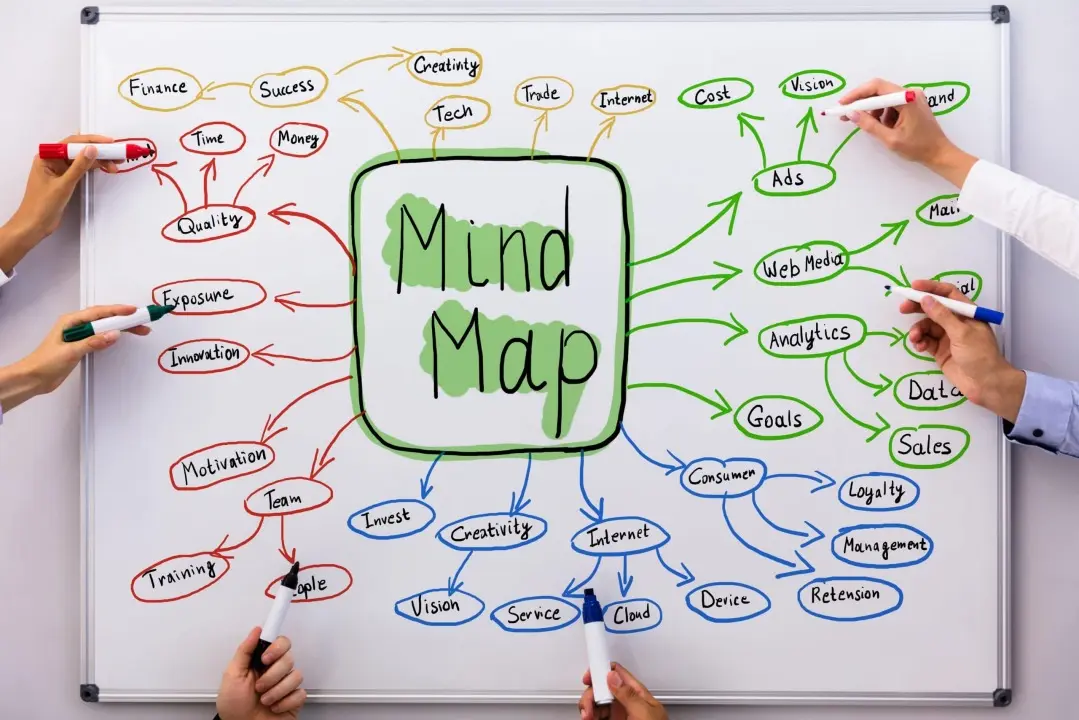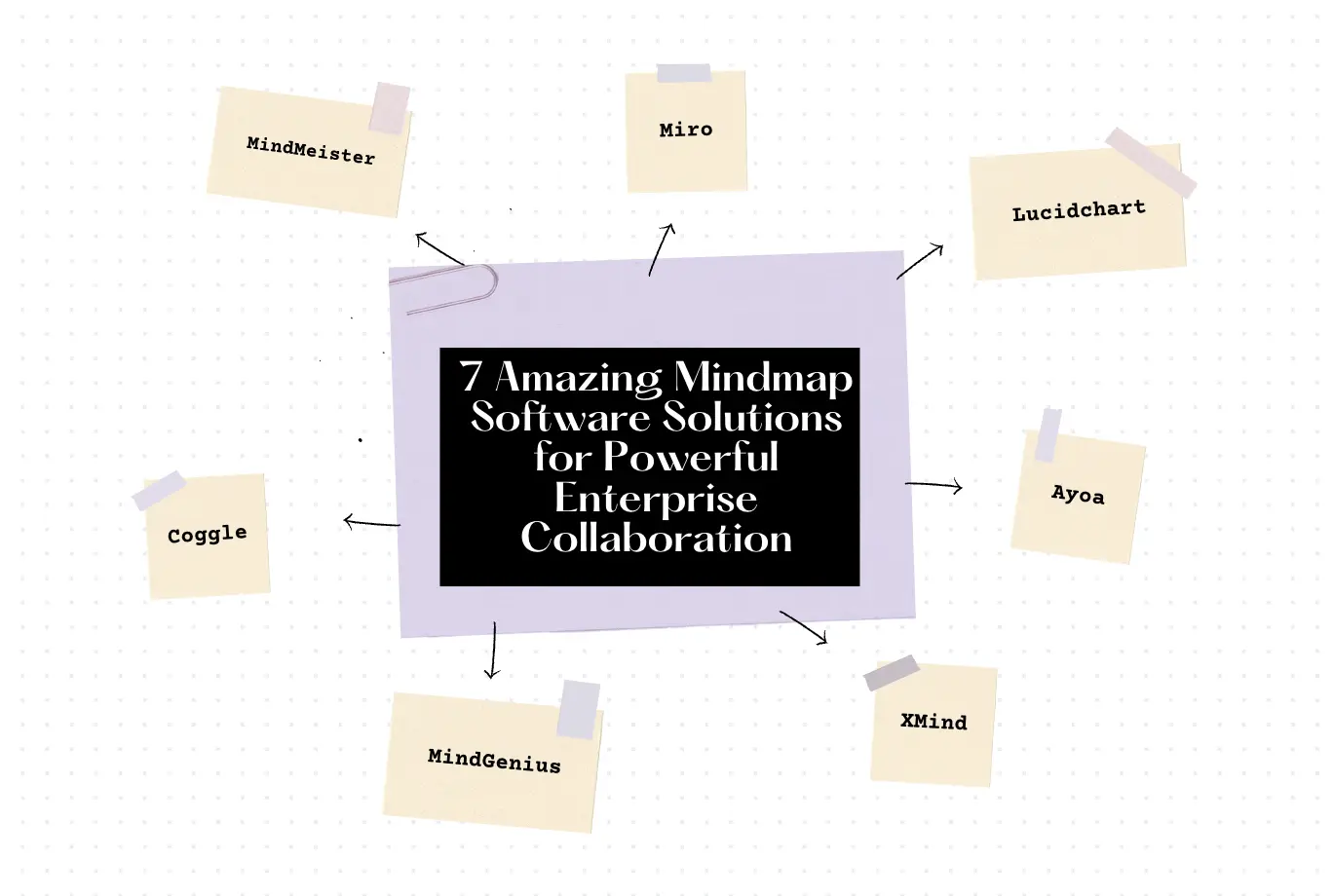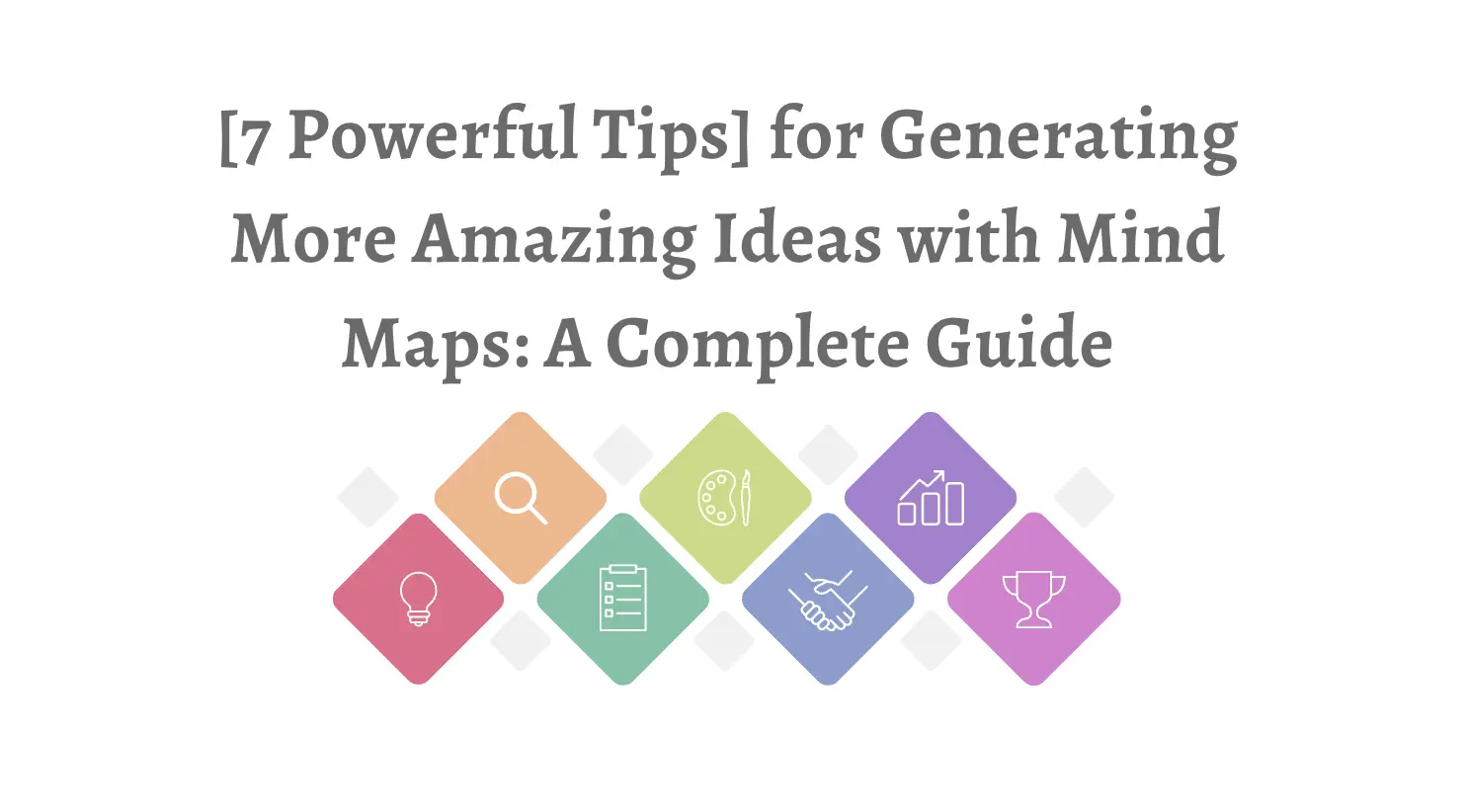Brainstorming is a crucial part of any creative process, helping to generate ideas, solve problems, and innovate. Mindmapping, a visual tool that organizes information hierarchically, is an excellent way to enhance brainstorming sessions. This blog will explore ten powerful brainstorming exercises using mindmaps, providing practical techniques to unleash your creativity and organize your thoughts effectively.
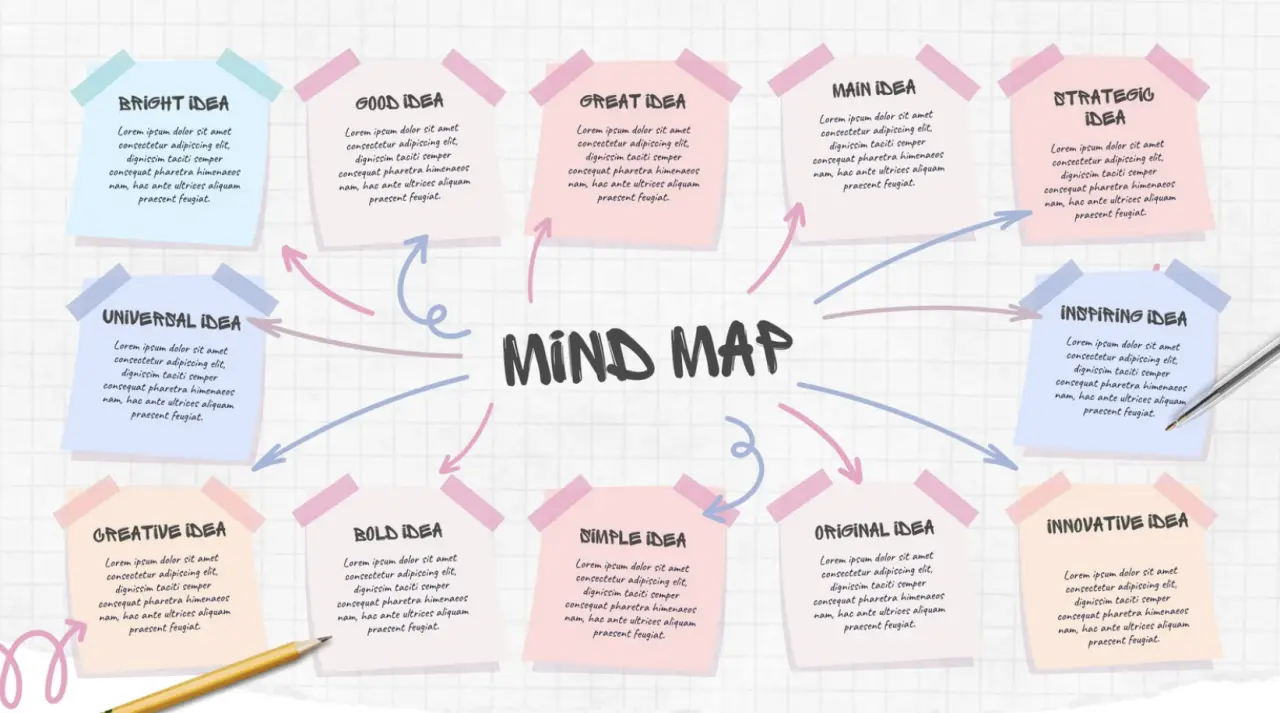
Image from: Canva
1. The Classic Brainstor
Start with the Central Idea
To create an effective mindmap, begin by placing your central idea or problem in the middle of the map. This central idea acts as the core from which everything else will radiate. From this center, branch out with related sub-ideas or potential solutions, organizing them in a logical sequence. As you continue to expand, further branch out from these sub-ideas, adding more details until you have a comprehensive and visually structured map of all your thoughts and ideas. This method is particularly powerful because it allows you to organize your thoughts in a clear, visual manner, making it easier to identify connections and spot any gaps in your thinking.
Applying Mindmapping to Real-World Scenarios
For instance, if you’re planning a marketing campaign, start with the campaign name in the center. From there, create branches for key elements like the target audience, marketing channels, budget, and timeline. Each of these branches can then be further divided into specific strategies and tactics, providing a detailed roadmap for your campaign. This approach not only enhances clarity but also sparks creativity by visually laying out all the possibilities.
2. SWOT Analysis Mindmap
Mind Mapping for Strategic Analysis
Create a mind map with four main branches: Strengths, Weaknesses, Opportunities, and Threats. This method is an effective tool for analyzing your project, business, or idea. By filling in these branches with relevant points, you can gain a comprehensive understanding of both internal and external factors, aiding in strategic planning and decision-making.
Applying the SWOT Mind Map to Real-World Scenarios
For example, in the case of a new product launch, you might list unique features under “Strengths,” analyze high costs under “Weaknesses,” identify growing market demand under “Opportunities,” and assess competitive pressures under “Threats.” The power of this mind mapping technique lies in its ability to provide a clear visual representation, helping you to more intuitively understand and manage the various factors influencing your project, ultimately laying the groundwork for successful strategic planning.
3. The SCAMPER Technique
SCAMPER is a powerful tool for stimulating creative thinking, and it stands for Substitute, Combine, Adapt, Modify, Put to another use, Eliminate, and Reverse. By creating a mind map with these seven branches, you can thoroughly explore each aspect of your idea or problem. This method is amazing because it encourages you to look at your idea from different angles and perspectives, often leading to innovative solutions.
Applying SCAMPER to Product Redesign
For example, during a product redesign, you might Substitute materials, Combine different features, Adapt the product for new uses, Modify the design, Eliminate unnecessary elements, or even Reverse the entire concept to gain a fresh perspective. This comprehensive approach helps you discover new insights at every stage, ultimately driving breakthrough progress in your project. The SCAMPER mind map not only aids in systematically analyzing your problem but also adds new dimensions to your creative process, making innovation both more exciting and productive.
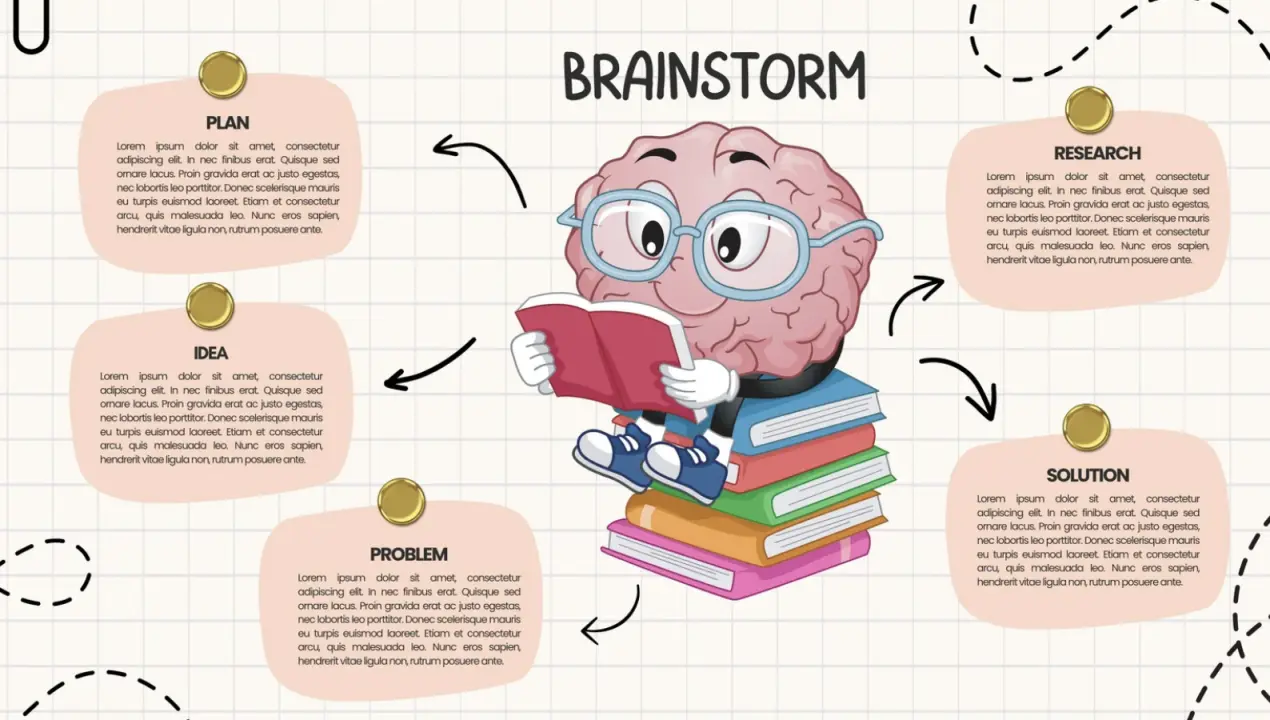
Image from: Canva
4. Idea Dump
Unleash Creativity with a Timed Brainstorm
Set a timer for 10-15 minutes and allow yourself to freely write down every idea that comes to mind related to your central topic. The key to this exercise is to avoid self-censorship—let your thoughts flow without judgment or filtering. This technique is powerful because it helps liberate your mind from the usual constraints that can stifle creativity, unlocking a steady stream of ideas.
After the timer goes off, take all the ideas you’ve captured and start organizing them into a mind map. Once you’ve gathered a wealth of thoughts, you can begin to categorize and refine them, transforming what was once a chaotic brainstorm into a structured and insightful plan. For example, if you’re brainstorming blog topics, start by placing “Blog Topics” at the center of your mind map and jot down any ideas that come to mind. Later, you can organize these ideas into categories such as technology, lifestyle, business, and more, creating a clear and organized framework for future content. This approach not only stimulates creativity but also provides a solid foundation for developing your ideas further.
5. The Five Whys
Start with a Clear Problem Statement
Begin by placing a clear problem statement at the center of your mind map. From there, engage in the “5 Whys” technique: ask “Why?” five times, each question branching out from the answer of the previous one. This iterative process allows you to dig progressively deeper into the issue, uncovering layers of causes until you reach the root cause. The power of this method lies in its ability to move beyond surface-level symptoms, helping you to identify and address the core problem rather than just treating the superficial issues.
Uncovering Root Causes for Lasting Solutions
For instance, if you’re facing a drop in sales, you might start by asking, “Why did sales drop?” If the answer is “Poor marketing,” you then ask, “Why is the marketing poor?” and continue this process until you uncover the underlying cause, such as inadequate market research or a misalignment with customer needs. By using this approach, you gain valuable insights that can lead to more effective solutions, ensuring that you tackle the real problem and not just its manifestations. This method not only sharpens your problem-solving skills but also ensures that your efforts lead to meaningful and lasting improvements.
6. Mindmap Storyboarding
Structuring Your Story or Project with a Central Idea
To effectively outline a story or project, begin by creating a mind map with your main plot or objective at the center. From this central idea, branch out to key elements such as major events, characters, settings, and subplots. Each of these branches can then be further expanded to include more specific details, such as character development, thematic elements, and pivotal scenes. This technique is powerful because it offers a clear and visual representation of your entire story or project, making it easier to grasp the big picture and understand how all the different elements are interconnected.
Creating a Cohesive and Well-Structured Final Product
By organizing your thoughts in this way, you can ensure that every part of your narrative or project contributes meaningfully to the overall goal, helping to create a cohesive and well-structured final product. For instance, when outlining a novel, you would place the main plot in the center of your mind map and then branch out to include key events that drive the story, character arcs that show how your characters evolve, settings that create the world of your story, and themes that add depth and meaning. This approach not only aids in planning but also in refining your story or project, making it a versatile tool for writers, project managers, and creatives alike.
7. Reverse Brainstorming
Reverse Brainstorming: Focusing on Problems
Instead of focusing on brainstorming solutions, try flipping the process by brainstorming potential problems or ways to exacerbate the issue you’re trying to solve. Begin by placing the central problem in the middle of your mind map and then branch out to explore all the possible causes and factors that could contribute to this problem. This reverse brainstorming technique is incredibly effective because it helps you to identify weak points and potential issues that might be overlooked during a traditional solution-focused brainstorming session.
Identifying Root Causes for Stronger Solutions
By thoroughly mapping out the factors that could lead to or worsen the problem, you gain a clearer understanding of what needs to be addressed to prevent these issues from occurring. For example, if your goal is to improve customer service, start with “Bad Customer Service” as the central node of your mind map. Then, branch out to potential causes such as “Long wait times,” “Unfriendly staff,” “Lack of product knowledge,” and other related issues. This method not only helps you to pinpoint the root causes of the problem but also gives you a comprehensive view of the challenges that need to be tackled, leading to more robust and effective solutions. By anticipating and understanding the problems in this way, you can develop strategies that are more targeted and preventative, ultimately leading to a stronger and more resilient outcome.
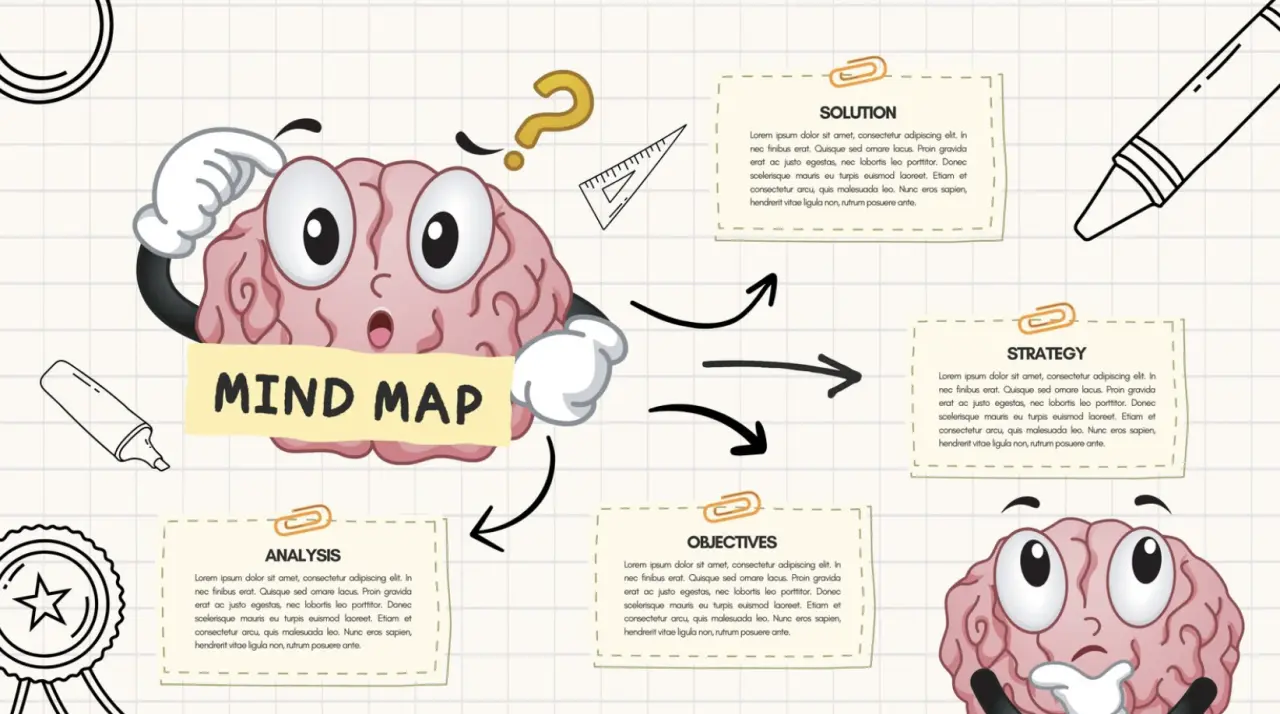
Image from: Canva
Visualizing Relationships with Concept Maps
Start by placing your main concept at the center of your mind map, and then branch out to related concepts and ideas. As you expand your map, use lines to connect these ideas, illustrating the relationships and hierarchies between them. This technique is powerful because it helps you understand and visualize the complex relationships and structures within a given topic, making it easier to grasp how different elements are interconnected. By organizing information in this way, you can see the bigger picture as well as the finer details, which is particularly useful when dealing with multifaceted subjects.
Structuring a Business Plan with Concept Mapping
For instance, if you’re creating a business plan, you would place “Business Plan” at the center of your map. From there, you could branch out to key components such as “Market Analysis,” “Financial Plan,” “Marketing Strategy,” and “Operations Plan.” Under each of these categories, you can further break down and link related ideas, such as “Target Market” under “Market Analysis” or “Budget” under “Financial Plan.” This method not only helps in structuring your thoughts but also in identifying the relationships between different aspects of your business plan. It provides a clear and organized framework that can guide your planning process, ensuring that all critical areas are covered and that you have a coherent strategy in place. Concept maps are particularly valuable for their ability to simplify complex information, making it more accessible and easier to communicate with others.
9. Mindmap for Decision Making
Visualize Your Options with a Decision-Making Mind Map
To effectively weigh your options and make informed decisions, start by creating a mind map with your decision at the center. From there, branch out to explore all possible options, and then further extend each branch to include the pros and cons of each option. This approach is amazing because it offers a clear visual representation of all your choices and their potential implications, making the decision-making process more structured and comprehensive. By laying out the pros and cons in a visual format, you can easily compare and contrast different options, helping you to see which choice aligns best with your goals and criteria.
Example: Choosing a New Office Location
For example, if you are deciding on a new office location, begin with “New Office Location” as the central idea. Branch out to potential cities you are considering, such as New York, San Francisco, or Austin. Under each city, create sub-branches to list the pros and cons of that location, such as cost of living, accessibility, availability of a local talent pool, proximity to key clients, and overall business environment. This method allows you to visualize the trade-offs associated with each option, ensuring that no critical factor is overlooked. It simplifies complex decisions by breaking them down into manageable parts, helping you make a well-informed and balanced choice. Moreover, the visual nature of the mind map makes it easier to communicate your decision-making process to others, whether it’s your team, stakeholders, or partners.
10. Project Planning Mindmap
Centralizing Your Project with a Mind Map
To effectively manage and visualize the entirety of a project, start by placing the project name at the center of your mind map. From this central point, branch out to key stages or major tasks that need to be accomplished. Each of these stages can then be further expanded into subtasks, along with associated deadlines and the resources required to complete them. This approach is powerful because it provides a comprehensive visual overview of the entire project, allowing you to see all the moving parts at once. It simplifies the process of tracking progress, managing tasks, and ensuring that nothing falls through the cracks.
Breaking Down a Website Redesign Project
For example, if you’re working on a website redesign project, you would begin by placing “Website Redesign” at the center of your mind map. From there, branch out to key stages such as “Research,” “Design,” “Development,” and “Launch.” Under each of these stages, you can create additional branches for specific subtasks. For instance, under “Research,” you might include “Competitor Analysis,” “User Surveys,” and “Content Audit.” For each subtask, you can also note important details like deadlines and the team members or resources needed to complete them.
Enhancing Project Management and Collaboration
This method not only helps in organizing the project but also in identifying potential bottlenecks or areas where additional resources might be required. By breaking down the project into stages and subtasks, you can manage the workload more efficiently and keep the project on track. Additionally, this visual format makes it easier to communicate the project’s structure and progress to stakeholders, ensuring everyone is aligned and aware of their responsibilities. Ultimately, using a mind map for project management fosters clarity, enhances collaboration, and supports the successful completion of the project.
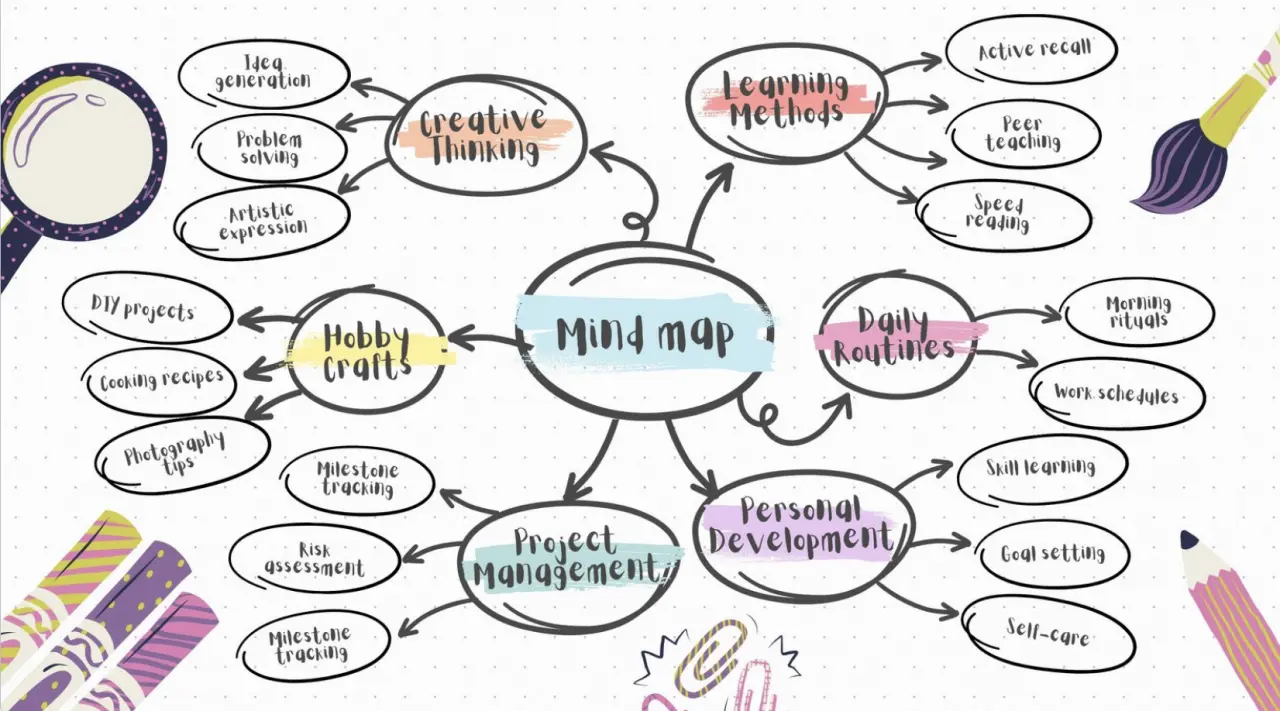
Image from: Canva
Using mindmaps for brainstorming exercises can significantly enhance your creativity and organization. These ten amazing techniques are just the beginning of what you can achieve with mindmapping. Whether you’re tackling a complex project, solving problems, or generating fresh ideas, mindmaps offer a powerful and visual way to brainstorm effectively. By integrating these exercises into your routine, you’ll unlock new levels of productivity and innovation. So, grab your favorite mindmapping tool and start transforming your brainstorming sessions today!


